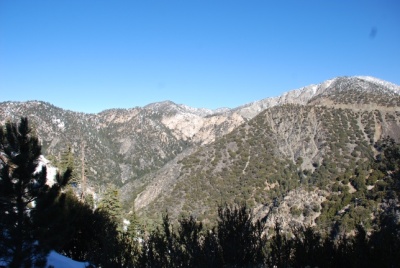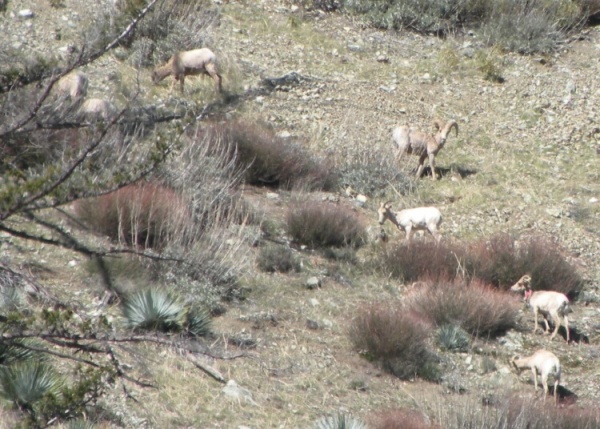Channelle Davis was trying her best, but I was getting nervous. The wildlife biologist with the Department of Fish and Wildlife was giving us newbies a crash course in how to identify big horn sheep, particularly the delicate differences between the young males and the females.
It’s all about the horn size, Channelle told us, as she posted slides up at the Forest Service Headquarters in Arcadia on a Saturday night. How far the horn curls around the animal’s head determines if it’s a class one, two, three or four. I was guessing three instead of a four, one instead of a two. Oh, how was I ever going to accurately do my job the next day? I didn’t want to fail…
Along with about a hundred or so fellow volunteers, I was getting an overview of a herd of big horned sheep that call the San Gabriel Mountains their home. This workshop would prepare us for the annual Big Horn Sheep Survey that has been taking place since the 1980s. Citizen volunteers trained in spotting and categorizing the hoofed mammal, help biologists learn more about the herd that has a mountain top view of Azusa, Rancho Cucamonga, Duarte and other eastern San Gabriel suburbs. Often helicopter counts are held in conjunction with ground counts – but not this year.
We volunteers were pumped up with information (“Rams can be as large as 300 pounds,” “They only eat grasses and shrubs”) but the most interesting facts was the herd had been as big as 700 in the 1980s. A big crash in sheep numbers from 1986-1993 brought the herd to dangerous low numbers of 100 or so. Since then, sheep population has been on the upswing every year. Last year, the estimate was 418. (2013 numbers will be soon available. Watch this spot for updates!)
The reason for the decline and upswing? Old growth and fire, we were told. In the late 80s, the hills and mountain tops were getting too thick with vegetation, making it hard for the big horns to move around, let alone reproduce and care for young. With the fire of 2003, the area was cleared out, new growth came and with that, higher numbers of sheep. As strange as it seems, fires can be great for wildlife.
We sheep spotters also learned that we may see collared sheep, big horns that are part of an on-going research project. More than 60 were collared in 2006 – about 14 still have radio-activated collars.
Before the workshop concluded, we signed up for our research group locations. Did I want to scramble over boulders, hike through streams or blaze through thickets? Naw, I wimped out and opted for the relatively “easy” location off Highway 39 near Crystal Lake. Six viewing sites were available on a three-mile paved road, not used anymore by the public. Yeah, I wasn’t ready to do the Hard-Core Get-Up-At-Crack-Of-Dawn-Loaded-Down-With-Gear-And-Hike-For-Hours route. Not this year, anyway.
Next morning, driving up to the location, I saw snow in the distant mountain tops. Little did I realize that the temperature conundrum I was about to enter. Sure it’s 80 degrees down in the basin…but up near 5,500 feet, life is completely different.
Arriving at our rendezvous point, big chunks of snow lined the side of the road. A fierce Santa Ana wind was blowing, swirling snow crystals up and around. The higher we walked up the road, the stronger the wind blew nearly knocking us off our feet.

The recent snow, we were told, may give us peepers an advantage. Snow at higher elevations should bring the sheep down to hunt for food. But we soon learned that blowing, below-freezing wind would just keep the sheep in our area hunkered down and immobile. I imagine them snuggling together, reading a good book with a cup of hot chocolate. (“No scampering for us today!”)
Still, trained sheep spotters were here and we had to try. I opted to join Group Number Three about two miles up the road, a spot where historically sheep have been recorded. I stomped through snow piles in my tennis shoes to find a rocky overlook where I placed my foamy garden kneeling mat and was set for spotting action.
The wind was torrential, but I was up for the challenge. Binoculars in hand, I scanned the hills, the bushes, the brush, the erosion lines of the surrounding landscape. I looked for white rumps, long legs or anything that moved. Alas, in the hour I sat there, I only witnessed a car moving up on Highway 2.
I kept imagining the moment when I would see a small group emerge from underneath a grove of Coulter pines. I envisioned me grandiosely recording the number, accurately categorizing the males with no hesitation and then, and then, even spying a lamb. I thought if I imagined it hard enough, I could will it to happen. No such luck.
After more than an hour, I attempted to eat my lunch, but because of the bitter wind, I didn’t want to take off my gloves. I regrouped with my fellow sheep-less peepers and we finally decided to head back down.
And that’s when it happened.
Group Two was packing up their site, when one volunteer thought she’d scan the nearby hill one more time. As we approached, we heard her joy in discovering a small herd. My camera and binoculars were around my neck and, Halleluiah, I spotted them, too. Far off in the distance, they effortlessly moved over a thick rock slab and wandered between trees. Three rams, I saw, but more were out there. “I counted eight,” said someone. “I counted 10,” said another. “I just saw wild sheep!” I told myself.
I was overjoyed on the ride back down and the rest of the day. Later, I heard from Chanelle Davis that her group saw sheep right near their rendezvous location. Sheep were everywhere at her location…and no blowing snow‼! “We just looked up and there they were!” she said. “Don’t rub it in,” I told her. Of course, she had to gloat and sent me photos from her excursion. Show-off.
Still, as Chanelle and I talked, I realized that even though I didn’t hit a mother lode of sheep my first time out, the experience reinforced the notion that wildlife is everywhere around us in Southern California. Maybe as I was sitting there in the freezing wind, a sheep was observing me from a high perk. We humans just need to sit still more and observe.
Yes, there is something to be said for being in the quiet of nature, even when the wind whistles through the pine branches and stings your face. You know what nature is saying? I’ll tell you what nature is saying: “Where is your scarf, you big dope? Don’t you know it’s cold up here? What an idiot….”
That said, yeah, I probably will sign up for the survey next year. I mean, come on. Nature can’t certainly have the last laugh, can she?
To register for the next big horn sheep survey, visit here.





